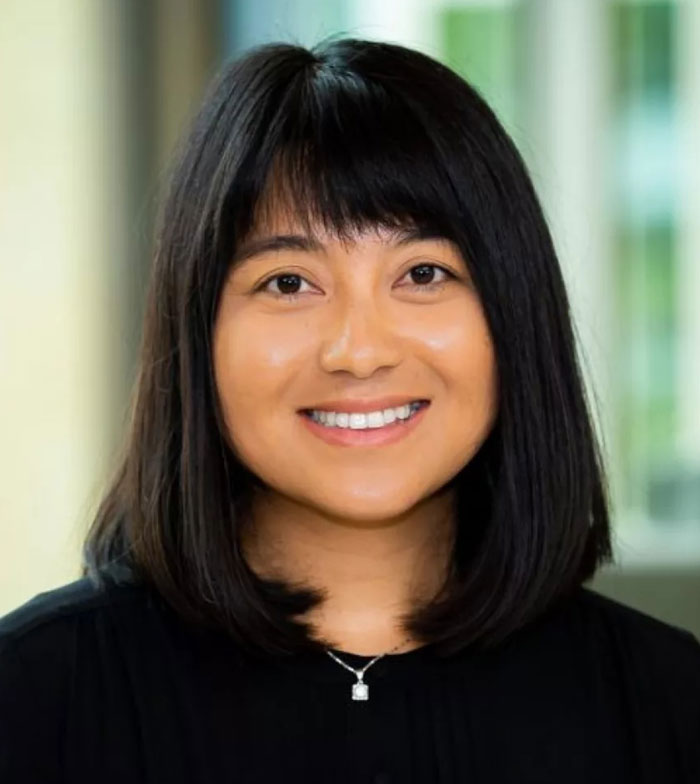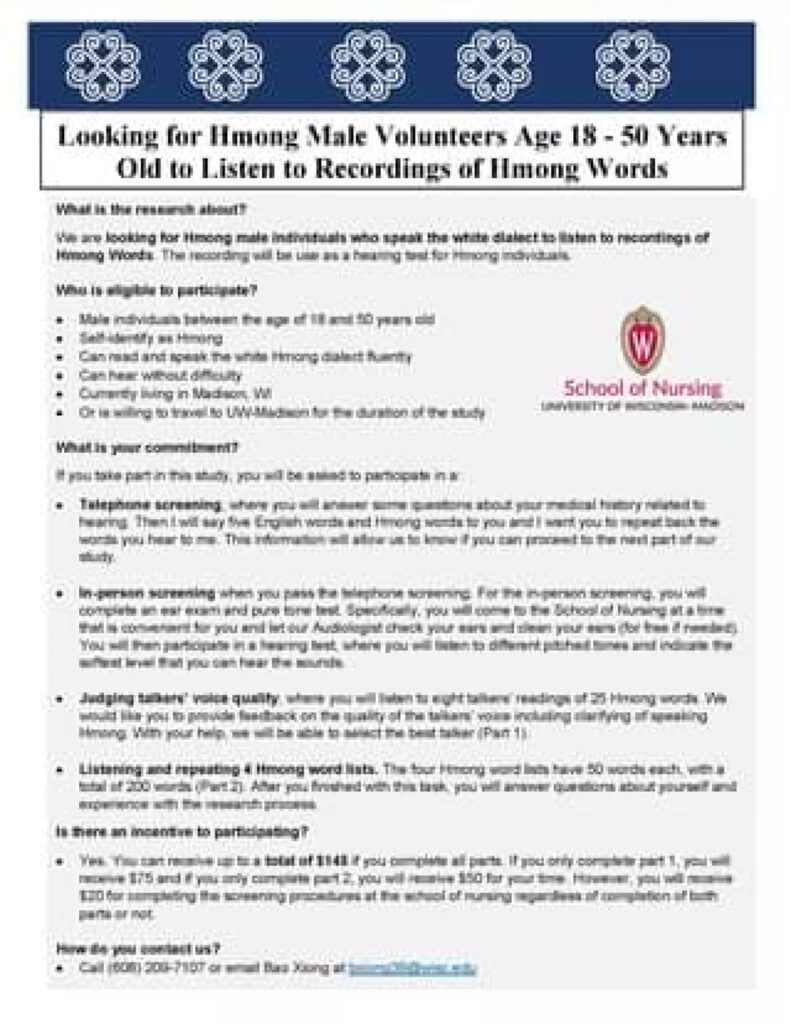Wisconsin Researchers Develop First Hearing Test for Hmong Community
WUWM 89.7 FM | By Lina Tran
About four years ago, Maichou Lor was living in New York completing a postdoctoral fellowship, when family members back home in Wisconsin kept telling her that her dad’s hearing was getting worse.
“He wasn’t responding to conversations even though he had a hearing aid,” said Lor, now an assistant professor of nursing at the University of Wisconsin-Madison. “I brought him in to see his doctor through the ENT clinic here at UW-Health.”
Lor and her father are Hmong; she joined him at the appointment as an interpreter, since he doesn’t speak English. At the clinic, his physician told Lor there was a limit to what he could offer him.

“I told her that there was a limitation in the test,” said Burke Richmond, an assistant professor in the ear, nose, and throat division — known as otolaryngology — at the University of Wisconsin-Madison. “I could not give her all the information that I would otherwise be able to provide if he were an English-speaking individual.”
Part of the evaluation is a word recognition test, which assesses when speech is loud enough for someone to understand. It helps doctors identify the severity and type of hearing loss and come up with a treatment plan, such as whether hearing aids will work or if a cochlear implant is viable.
During the test, patients listen to a recording of words, with instructions to repeat the words as they hear them. But, for the most part, the test is only available in the most common languages — English and Spanish. If someone’s language has a smaller population of speakers, they don’t take the test.
“There’s no substitute,” Richmond said.
Wisconsin is home to the third-largest Hmong population in the U.S., following Minnesota and California. Within the state, they represent the largest Asian American ethnic group. As the community ages, hearing loss is becoming a widespread problem. But few clinics are equipped to treat Hmong-speaking patients — amounting to a health disparity in their care, experts say.
After Lor and Richmond met, they undertook a years-long, interdisciplinary collaboration that resulted in the first Hmong hearing test of its kind.
Hearing evaluations typically involve a couple different tests. In one of them, patients listen to beeps and tones and press a button when they hear it. “That’s easy enough to explain to someone who speaks a different language,” said Jennifer Ploch, a clinical audiologist involved with the project, then at UW-Madison.
But when it comes to the word recognition test, language can be a barrier. According to University of Wisconsin data, 68% of the older Hmong population does not speak English. Omitting the test makes it harder to know the best option for the patient. Without that data, doctors have to rely on observations and patients’ descriptions of their symptoms.
According to Ploch, poor performance on a word recognition test can tell audiologists that there may be a tumor on the hearing nerve. Or, depending on other symptoms, someone could be suffering from Ménière’s disease, a disorder of the inner ear. In other cases, she said, the test can indicate whether a patient is a good candidate for a hearing aid.
Lor’s father has a complicated hearing history, Lor said. He experienced significant hearing loss as a child, due to an untreated ear infection. After immigrating to the U.S., he began using hearing aids, but as he aged, his hearing declined further. That can be particularly isolating for Hmong speakers, since the spoken language is, for many, the only way to communicate: Most Hmong individuals don’t use the written language, which was created in the 1950s by Christian missionaries.
“There was a conversation about whether or not he would be a potential candidate for a cochlear implant,” Lor said. “We couldn’t proceed because there [wasn’t a] word recognition test.”
When Lor and her father came through his office, Richmond knew about Lor’s research on health disparities. He asked if she wanted to make a Hmong word test with him. He remembers telling her, “If we can create this list, we can bring it back and use it for your dad, improve his healthcare, and hopefully improve health outcomes for other people as well.”
Writing a Word List
The English test is designed to use everyday words like “bat” and “kick” that anyone would understand. At the same time, it shouldn’t be possible for test-takers to predict or guess what the words are without actually hearing them. Historically, one of the ways audiologists have accomplished that is by writing the word list so that it reflects the phonetic make-up of the language.
“If the language has a bunch of S’s, you want to have a bunch of S’s in the words,” explained Lynsey Wolter, an associate linguistics professor at the University of Wisconsin-Eau Claire, who led the writing of the Hmong word list. “But not too many because then someone will just guess.”
But no one had studied how frequent different sounds are in Hmong.
“And there are a lot,” Wolter said. “There are about twice as many consonant sounds in Hmong as in English. Hmong is also a tonal language. The intonation of the word — whether the tone is higher or lower, going up or going down — can change the meaning. We had to take that into account as well.”
Wolter said it was critical to work with native Hmong speakers, so she quickly brought two of her students on board. While there are two dominant dialects of Hmong, the study focused on White Hmong, which is more commonly spoken in the U.S.
Kao Lee Lor, then a senior, was one of the student collaborators. She always loved languages and grew up hearing many of them at home, reflecting the places her parents had lived before immigrating to Wausau, Wisconsin. They were born in Laos and grew up in a Thai refugee camp. They enjoyed television shows, films, and music in Thai, Hmong, and Hindi.
Once, Lor wanted to watch a Thai soap opera, but it had no subtitles. Usually, she watched them — as she put it — subbed or dubbed, but in this case, neither was available.
“It sounds so crazy, but I think I just remember waking up one day, and being like, ‘Wow, I think I understand these languages more than I thought I did,’” she said. “I was thoroughly surprised that I understood at least 50% of it.”
To pick words for the list, the students dug through Hmong texts, entering all the words into a massive spreadsheet.
“We compiled a bunch of different Hmong folklore and folktales, Hmong kids’ books, anything we could find,” Lor said. Some of the tales were familiar to her and her collaborator, oral traditions that had been passed down from their grandparents and parents. But there was little time to appreciate the stories in a new light; their focus was gathering as many words as they could.
“Once we were able to extract these words from these texts, we were able to break these words up into [their] parts, and then count the frequency of how much these consonants, sounds, vowels, and tones occurred,” Lor said.
The work that summer gave Lor new appreciation for how language can both unite and divide. Her own father, who speaks little English, has experienced hearing loss and is stubborn about wearing his hearing aids.
She imagined him taking an English word recognition test. “For me, it would be a matter of is he hearing but not understanding? Or is he not hearing at all?” Lor said. “When you can’t pinpoint a problem, you can’t find a solution.”
With numbers on how frequent different sounds are in the language, the linguistics team picked words to meet those targets. They wrote four lists of 50 words each, and sent it back to the UW-Madison researchers.

Testing the Test
Word lists in hand, the researchers asked the Hmong community to nominate clear, fluent speakers. Then, to validate the list, they tested the Hmong test against the English version on a group of bilingual speakers. They published their results in December.
“This study is the first to develop and validate a monosyllabic word recognition test in the White Hmong language,” the authors wrote.
“Hmong community members are very excited because we’ve not had anything for the community that’s of the Hmong language,” said Maichou Lor, a nursing researcher at UW-Madison. “And we have an aging population that’s coming through.”
On top of that, community outreach over the course of the study indicated that many Hmong people were not seeking care for hearing loss, whether because of language barriers or cultural stigma. Lor hopes that their test will help bridge the gap. According to the researchers, hearing loss is associated with isolation, depression, cognitive decline, and diminished quality of life.
“A study like this can potentially raise health quality across the population for other reasons, if you’re addressing this comprehensively,” Richmond said.
Now that the test has been validated, the researchers want to see it implemented at clinics where Hmong communities elsewhere can use it. Hurdles remain: The test requires a native speaker to grade it, and few clinics have the language skills to score the test in-house. As part of the study, the researchers developed training for interpreters. They’re also exploring ways interpreters could work remotely.
Throughout this process, the researchers wound their way down many science rabbit holes. Who is the ideal speaker for such a test — male or female? Since they conducted much of their trials throughout the COVID-19 pandemic, how do masks affect the test? And, how can Western science and traditional knowledge come together, for the benefit of the patient?
“Even with my father, who recently experienced tinnitus, there are beliefs that maybe there might be some spiritual-related cause to it,” Lor said. “Whether it’s like, your ancestors would want to have some kind of ceremony done, or maybe your spirit or soul is frightened by something.”
In order to understand his symptoms, her father sought the advice of both Richmond, his physician, and spiritual leaders in his community. Ultimately, Richmond was able to give the test to Lor’s father.
“It’s wonderful,” Richmond said. “It was sort of a clinical observation. A need — let’s see if we can fix this. And it took a long time, but we did it and we got to use it for him. And it was clinically useful.”
Over the course of the project, some questioned why they were doing all this work. Hmong speakers are aging, and the younger, bilingual generation can take the English test. Richmond said there was a gap and they filled it. It was the right thing to do.
